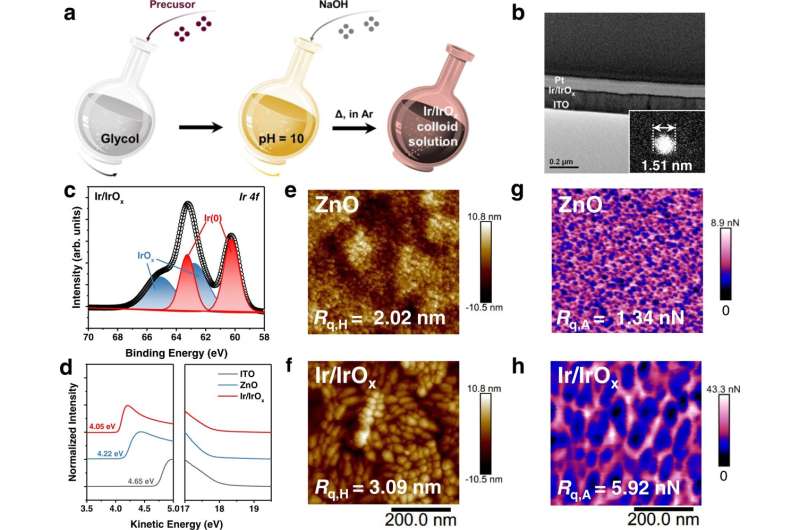This article has been reviewed according to Science X's editorial process and policies. Editors have highlighted the following attributes while ensuring the content's credibility:
fact-checked
peer-reviewed publication
trusted source
proofread
Researchers develop Ir/IrOx electron transport layer for stable organic solar cells

In recent years, the device efficiency of organic solar cells (OSCs) has been significantly improved, but the unsatisfactory stability restricts future commercialization processing.
Inverted device structure has been widely adopted to enhance the device stability of OSCs. However, zinc oxide (ZnO), the most commonly used electron-transporting material, is photocatalytic active, which could accelerate the decomposition of the active layers under continuous light illumination, and then lead to the degradation of device performance. Therefore, developing new electron-transporting materials is extremely critical for utilizing efficient and stable OSCs.
Recently, Prof. Zhou Huiqiong's group from National Center for Nanoscience and Technology (NCNST) of the Chinese Academy of Science (CAS) has developed a new electron transport material Ir/IrOx to enhance the stability of OSCs. The study was published online in Nature Communications.
Prof. Zhou's group has carried out a series of studies focused on the stability of OSCs. By incorporating organic electron transport material PFN-Br into the ZnO layer, the surface energy of the interface layer was regulated, resulting in the enhanced device stability (Journal of Materials Chemistry A ). Furthermore, the polyaspartic acid (PASP) film was deposited on the ZnO film to suppress the degradation caused by illumination, leading to the improved stability of organic solar cells. (Journal of Materials Chemistry C).
In this study, the Ir/IrOx nanoparticles prepared by the mild colloid solution method were utilized as the electron-transporting material in organic solar cells instead of the common ZnO layer.
Benefiting from the suitable work function, heterogeneous surface energy distribution in nanoscale and optimized optical field, the Ir/IrOx-based devices exhibited more efficient charge extraction and suppressed charge recombination compared with the ZnO-based devices, leading to improved device performance.
Due to the absence of photocatalysis, the active layer deposited on Ir/IrOx film exhibited more stable component distribution and morphology, elongating the lifetime of Ir/IrOx-based devices under storage in inert atmosphere, thermal aging and maximum-power-point (MPP) tracking conditions. In particular, the T70 lifetime of Ir/IrOx-based devices under thermal aging exceeded 10,000 hours.
Moreover, the better stability of Ir/IrOx-based devices under UV irradiation and thermal cycling between -40℃ and 85℃ illustrated the huge potential of OSCs with Ir/IrOx operating under extreme environments.
"The appropriate optoelectric properties and photocatalytic inactivity of Ir/IrOx allow us to investigate the mechanism of photo-induced degradation in OSCs, finally achieving the enhanced device stability under various aging condition," said Prof. Zhou. "We envision that our results are also helpful to the related work focused on the intrinsic stability of OSCs."
More information: Yanxun Li et al, Lifetime over 10000 hours for organic solar cells with Ir/IrOx electron-transporting layer, Nature Communications (2023). DOI: 10.1038/s41467-023-36937-8
Journal information: Journal of Materials Chemistry A , Nature Communications
Provided by Chinese Academy of Sciences





















